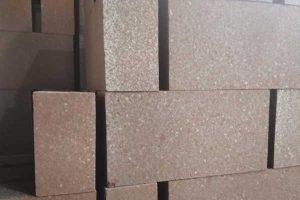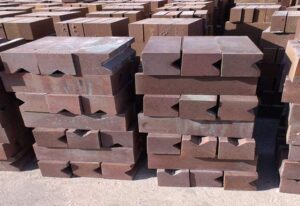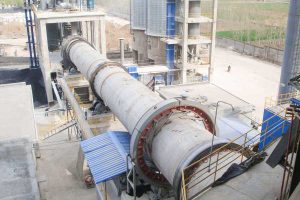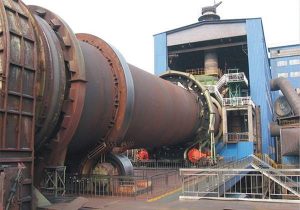Magnesium-Chromium Refractories For Cement Kilns
Magnesium-chromium refractory products are refractory bricks made of chromite ore and sintered magnesia as raw materials.
مرحلتها المعدنية الرئيسية هي الكالسيت والإسبنيل, according to whether the amount of chromite in the raw material is over 50%, respectively called chrome-magnesite bricks and magnesia-chromium bricks. The cement industry mainly uses magnesia-chromium bricks.
The building materials industry for cement rotary kiln separately developed JC/T497-1992 (96) building materials industrial kiln directly combined with magnesium-chromium bricks, according to the physical and chemical properties into five, according to the appearance of quality into three levels.
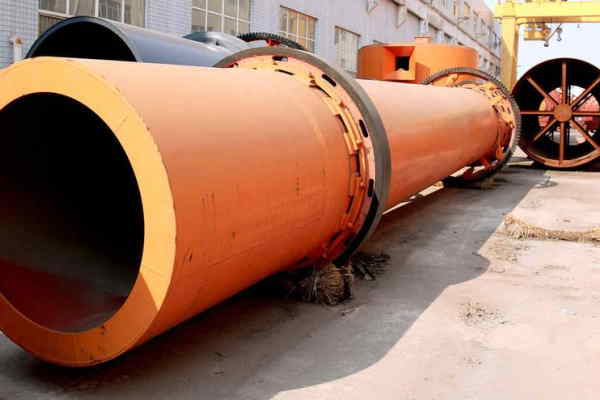
Alkali Refractories
Alkali refractories have good properties such as high-temperature forging resistance, مقاومة التآكل الكيميائي, إلخ.
It is the key kiln lining material to achieve high quality, high production, low consumption, and long-term safe operation of cement kiln production.
لكن, it also has the main disadvantages of easy moisture deterioration, high thermal expansion rate, الموصلية الحرارية العالية, and poor thermal shock resistance.
في الوقت الحاضر, applicable to the cement kiln of imported and domestic alkali refractory materials are mainly direct combined magnesia-chromium brick, semi-direct combined magnesia-chromium brick, ordinary magnesia-chromium brick, dolomite brick, zirconium and zirconium-free special magnesia brick, الإسبنيل, and chemically combined non-burning magnesia-chromium brick.
New Cement Kilns Use Chrome-Free Brick – Magnesium Composite Spinel Brick
To develop chrome-free bricks suitable for cement kiln firing belts with low operating rates (<90%) or high-temperature wheel belt areas with high mechanical stress, the project successfully developed magnesium composite spinel bricks, which are made of high-purity magnesium sand and iron-aluminum spinel as the main raw materials.
The introduction of iron-aluminum spinel can react with cement clinker to produce high viscosity C4AF and C2F, which improves the kiln skin performance of the brick.
On the other hand, the appropriate thermal expansion coefficient difference with high-purity magnesite improves the thermal vibration stability of the brick. Iron-aluminum spinel gradually decomposes into Fe2+ and Al3+ during firing and use, where Fe2+ ions diffuse into the surrounding magnesium oxide matrix.
في نفس الوقت, part of Mg ions also diffuse to the iron-aluminum spinel particles, and the residual Al3+ reaction generates magnesium-aluminum spinel, إنه, the brick contains iron-aluminum and magnesium-aluminum two kinds of spinel, so it is called magnesium composite spinel brick.
ارتفاع طوب الألومينا
High alumina brick has high compressive strength, load-softening temperature, ومقاومة جيدة للصدمات الحرارية. Because of its low price and good quality.
It has been widely used in various cement kilns. Various phosphate-bonded high alumina bricks, all have high strength (not less than 60MPa), مقاومة جيدة للصدمات الحرارية, إلخ., but creep at high temperatures. So when used in the vaulting parts, should be forged high alumina bricks.
The introduction of a small amount of ZrO2 in the high alumina brick, using the phase change of ZrO2 monoclinic and tetragonal, can improve the existence of microcracks and thermal shock resistance.
A suitable particle gradation is selected to give the brick a higher apparent porosity but also a higher strength, thus reducing its thermal conductivity and thermal expansion.
The use of a thin glaze film on the transit surface of the cement kiln protects the brick from further alkali corrosion.
High alumina bricks suitable for cement kilns mainly include phosphate-bonded high alumina bricks, phosphate-bonded high alumina wear-resistant bricks, flake-resistant high alumina bricks, chemically bonded (خاص) طوب عالي الألومينا, و ordinary high alumina bricks.
Alkali Resistant Brick
Alkali-resistant bricks have different alkaline and erosion resistance. Under certain conditions can react with the kiln material and kiln gas in the alkali compounds. And in the rotation of the rapid formation of closed dense protective glaze to prevent continued penetration and brick alkali cracking damage to the kiln. Especially.
It is one of the indispensable kiln lining materials for the new dry kiln. This series of alkali-resistant bricks includes ordinary alkali-resistant bricks, high-strength alkali-resistant bricks, alkali-resistant heat insulation bricks, and vaulted alkali-resistant bricks.
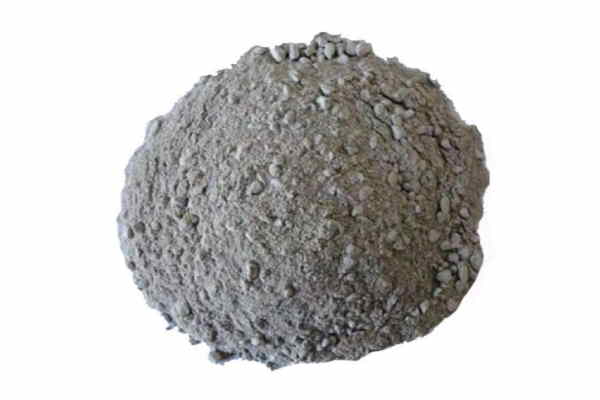
Refractory Castables
Refractory castable has the characteristics of a simple production process, high production energy consumption, and flexible and convenient use.
In cement kiln systems, it is characterized by its increasingly widespread application in preheating systems with complex structures.
Refractory castables suitable for cement kilns mainly include corundum castables, high alumina castables, alkali-resistant castables, and lightweight castables.
Silica-Mo Bricks For Cement Kiln Transition
The process characteristics of the transition zone determine frequent changes in the kiln skin and therefore require a higher resistance to spalling of the refractory bricks.
فضلاً عن ذلك, as the liquid phase starts to appear in this zone, the refractory bricks are subjected to a correspondingly higher heat load.
If there is no kiln skin, the bricks in this area are also required to have good chemical resistance and wear resistance.
Our factory has compared the performance of various refractory bricks. The chemical composition of silica-mo bricks is mainly Al2O3 and SiO2, with low porosity, strong resistance to sulfur and alkali corrosion, and different thermal shock stability and mechanical strength index.
Selection Of Refractory Castables For Cement Kiln Mouth
With the continuous development and perfection of large dry rotary kiln technology, the production scale of clinker mouth is expanding.
And the operating conditions of its equipment have new characteristics, which put forward higher requirements for refractory castables, especially kiln mouth castables.
Kiln mouth kiln lining is one of the weak kiln linings in large rotary kilns.
In the production of large dry kilns, the kiln temperature at the rotary kiln mouth can be as high as about 1400°C.
The temperature of the clinker leaving the kiln can be as high as 1400°C, and the temperature of the secondary air entering the kiln can be up to 1200°C.
The kiln mouth is almost completely exposed to the high-temperature flame radiation of 1700°C, and the high-temperature particles of about 1400°C are large and strong.
The working conditions are very harsh, and the service life of the kiln mouth lining material seriously restricts the service life of the whole kiln.
Frequent brick dropping caused by easy deformation of the kiln mouth, a significant increase in secondary air temperature
The kiln slope increases, the rotational speed is accelerated, there is no stable kiln skin at the kiln mouth.
And the kiln lining must be able to withstand clinker abrasion, high-temperature airflow scouring, and alkali corrosion of the material. فضلاً عن ذلك, it is also subject to the impact of kiln failure and rapid cooling and heating.
Rotary kilns suffer from frequent kiln stoppages and more thermal shocks to the kiln refractory for a variety of reasons. Relevant statistics show that more than 80% of kiln stoppages are caused by corrosion of local refractory.
According to the characteristics of the weak kiln mouth, more castables with heat shock, impact, and wear resistance are used.
When using, weld anchor pieces on the kiln body, pour the kiln mouth with corundum or high alumina steel fiber reinforced castables as a whole, and use high-performance kiln mouth refractory castables or improved kiln mouth refractory castables, which can effectively prevent the above damage.
Make the use cycle of kiln door refractories synchronized with the kiln firing belt.
What about cracking, تقشير, and easy wear of refractory materials? To solve the problem, you need to dig from the root cause and analyze the real reason.
PER refractories has been engaged in refractory material production, research, and development services for many years, and can solve various difficult problems of high-temperature kiln lining, welcome new and old friends to consult and technical exchange.

